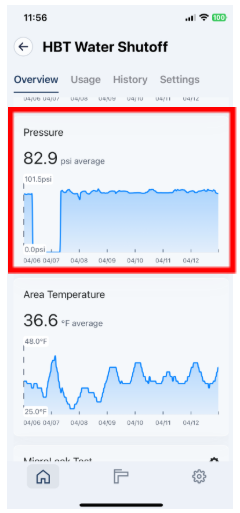Alta presión de agua
¿Qué significa "alta presión de agua"?
High Water Pressure is a advertencia related to the home water system experiencing higher water pressure than normal at a certain period of time. High Water Pressure can be very dangerous as it makes the home plumbing vulnerable to pipe bursts. As an analogy, imagine an air balloon that's being pumped with excessive air. At some point, that balloon is vulnerable to pop.
Causes of High Water Pressure:
-
Water Utility Supplier: High Water Pressure is often caused by high water pressure being supplied to the home from a water utility. La compañía de agua local también puede mantener una alta presión en su área para satisfacer las necesidades de los edificios altos o las bocas de incendios.
-
Downhill: Do you live at the bottom of a hill? Esa es una causa común de alta presión de agua porque el agua corre naturalmente hacia abajo.
-
Thermal Expansion: High pressure can additionally be caused by thermal expansion inside your home as the water volume changes due to heating by your water heater.
-
Water Pump: If you have a water pump, your pump could also be excessively pumping water into the home’s plumbing system.
-
Pressure Reducing Valve (PRV): Many manufacturers recommend repairing, maintaining or replacing the PRV every 5 yrs. Check to see if it is time to maintain, repair or replace your PRV.
¿Qué debo hacer si recibo una advertencia de alta presión de agua?
High Water Pressure is a warning related to the home water system experiencing higher water pressure than normal at a certain period of time. Average water pressure in the home is between 25-75 PSI.
-
Pressure Reducing Valve (PRV) Needed- Many homes are required to have a pressure reducing valve (PRV) to avoid high water pressure being supplied to the home. If your home doesn’t have a PRV, it may be time to get one.
-
PRV Needs Repaired/Maintained- If you have a PRV, some PRV manufacturers recommend repairing, maintaining or replacing the PRV every five years. Inspeccione la válvula reductora de presión (PRV) del hogar para detectar cualquier signo de daño o desgaste. In some cases where the PRV needs repair, you may notice that your PRV is making a noise or leaking water when water is running. Si no hay signos de daño o desgaste en la PRV, consulte el manual del fabricante para ajustar la PRV a una configuración más baja; esto ayudará a reducir el estrés de la alta presión sobre el sistema de plomería y los accesorios.
-
Thermal Expansion- If your high water pressure alert is due to thermal expansion, you will need to add a Thermal Expansion Tank. A symptom is experiencing high water pressure after using hot water and notice that your water pressure stabilizes after running some cold water.
Unwanted Effects from High Pressure
El efecto más común de la alta presión es la aparición de fugas en el sistema de plomería. Pueden ser fugas de agujeros diminutos y solo pueden aparecer en momentos intermitentes. Incluso una pequeña fuga puede causar problemas muchos más grandes si ocurre en un área en la que puede dañar las paredes o el piso.
La presión de agua alta o inconsistente también puede ejercer esfuerzo sobre los electrodomésticos, como la lavadora y el calentador de agua caliente, lo cual reduce su vida útil.
Solución de problemas
Check for Thermal Expansion
| Pasos |
|---|
|
From the Apps Home Screen, scroll down to Devices, and select your Flo Shutoff device
|
|
From the Flo Shutoff Home Screen, go to ‘Sensor Trends’ and select the time range you would like to view, then scroll on down to the Pressure section.
|
Click anywhere on the blue graph line to your plumbing system's current water pressure. Take note of the time stamp and pressure reading.  |
|
Run your Shower hot water Check pressure before and after a shower or an event where hot water is used (ex: dishwasher, laundry). The hot water should run long enough for the hot water tank to turn on. Check the pressure chart to see if your water pressure increases. If the water pressure significantly increases and spikes after running hot water, this strongly indicates thermal expansion and you may need to repair, replace, or install a Thermal Expansion Tank. |
Check Your Home’s Average Water Pressure
| Step | ||
|---|---|---|
|
From the Apps Home Screen, scroll down to Devices, and select your Flo Shutoff device.
|
||
|
From the Flo Shutoff Home Screen, go to ‘Sensor Trends’ and ensure the default of Last 7 Days is selected, then scroll on down to the Pressure section
|
||
|
View the PSI Average for your home (in this example, it is 82.9 psi average for the last 7 days) |
||
|
To view the high and low pressure readings for any given day, scroll up to ‘Sensor Trends’ and select Last 24h
|
||
|
Scroll down to the section labeled 'Pressure'. Click on anywhere on the blue graph line to see the PSI readings from the past 24hrs. In this example, the highest peak and lowest peak were selected. This provides information as to the range of PSI during the past 24hrs.
In this example the PSI ranged from 94.3 to 100.9. |
||
|
A normal pressure range is between 40-60 PSI. Consistent pressure above 80 PSI, installation of a Pressure Release Valve (PRV) is highly recommended to protect your homes plumbing, appliances and fixtures. If the water pressure drops significantly (more than 10 PSI when a faucet is opened) or when multiple fixtures are in use, it could indicate a problem with the PRV. Service or replace your PRV. |










